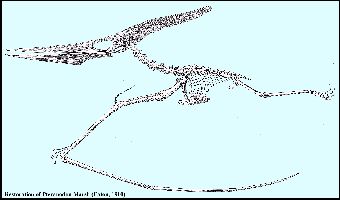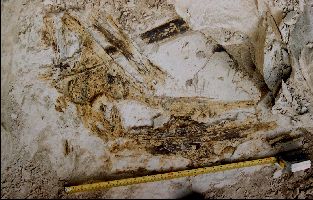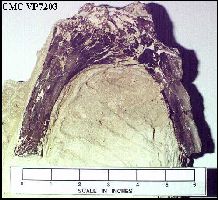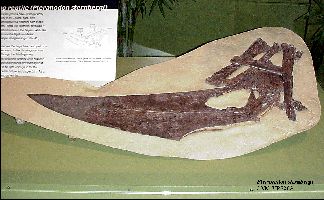
Pteranodon sternbergi dig
June, 1996
Copyright © 2000-2010 by Mike Everhart
Updated 11/06/2010
LEFT: A full scale model of a Pteranodon sternbergi in flight at the Sternberg Museum of Natural History.
 |
Pteranodons were a group of Late Cretaceous flying reptiles (not
dinosaurs!) that were characteristically toothless and tail-less (they did have short
tails), at least compared to pterodactyls from the Jurassic of Europe and elsewhere.
They grew to large size during the deposition of the Smoky Hill chalk (wingspreads of 7.5
m (25 ft) or more), and were even larger (e.g., Quetzalcoatlus northropi) near
the end of the Late Cretaceous. They were first discovered in the Smoky Hill Chalk by
O.C. Marsh in 1870. Literally thousands of partial specimens have
been collected since that time. Drawing adapted from Eaton, 1910. For more about the history and osteology of Pteranodon and Nyctosaurus, GO HERE: |
 |
On June 29, we returned to the site about 8 AM to take advantage
of as much of the cool morning temperature as possible. The first order of business was to
start taking the overburden off of where the rest of the fossil was expected to be. There
was about 3’ of hard tan chalk interbedded with calcite seams, covering an area of
about 4’ by 6’ that needed to be removed. Part of this was done right away in order to get a minimum working area and to expand the initial entry point to locate additional remains. The rest of the chalk was removed as needed over the next day and a half. All of the initial overburden removal was done with a heavy pick and flat bladed shovel (and lots of sweat!). The chalk was fairly hard and partially cross bedded, causing it to break up in mostly small, uneven pieces. This was hot work and not a lot of fun, so it was done in small increments. Approximately 2-4” (10 cm) of chalk was left above the fossil at this point. This was removed slowly, with an ice pick and brush, and occasional, careful use of my Estwing rock hammer. LEFT: The locality where the Pteranodon skull was found. A large, and relatively rare clam (Cladoceramus undulatoplicatus) found nearby firmly establishes the age of this specimen as Early Santonian (about 85 million years). |
| Note that all of the circa 1996 photographs on this page were taken with a Pentax 35 mm camera and print film. I have recently discovered that the best way to reproduce these old photos digitally is to photograph them with my digital camera INSTEAD of trying to scan them. Not sure what the difference is, but they turned out better than my scans. |
 |
LEFT: Eventually most of the skull was found to be in place, and
still articulated with the lower jaw. The skull was laying on it’s left side, with
the lower jaw closed. Working around the skull, we found several other wing bones,
including one that went directly under the crest. RIGHT: Close-up of the posterior portion of the Pteranodon skull, in right lateral view. I think that the complete skull would have been about a meter (39 inches) long in life. The crest, however, extended only about 6 inches (15 cm) above the orbit of the eye, not too impressive compared to the much larger (and more mature) type specimen of Pteranodon sternbergi at the Sternberg Museum. |
 |
Sunday was supposed to be even hotter, so we were back in the field by 7:45 AM. The Pteranodon skull was cleaned further in preparation for the application of more preservative and jacketing. At this point, the last of the overburden to the east and south of the skull had to be removed in order to allow for jacketing of the skull and turning of the jacket. Several of the wing bones around the skull were removed individually in order to cut down on the size (and weight) of the final jacket. In the process, a group of small bone pieces was isolated at the back of the skull.
At this point, the block containing the skull was isolated by digging a four inch cut completely around it. Once this was done, the block was undercut slightly to allow the jacket material to fill in and support as much of the chalk as possible, and to find a seam in the chalk that could be used to separate the block from the matrix. Once the undercut was completed, the exposed bones of the skull were soaked with the Bond 527 Cement / acetone mixture and allowed to dry.
Once the preservative had dried, aluminum foil was placed over the block to prevent the jacketing foam from contacting the specimen. A 4” wide piece of 1/4” plywood was added along the length of the skull to reinforce the jacket. Then a temporary form for the jacket was made of cardboard, placed around the block containing the skull, and supported with pieces of broken chalk. A two part mixture of isocyanate foam was prepared and poured into the form. The foam expands and cures in about half an hour, producing a hard, yet light jacket for the specimen.
 |
LEFT: In June, 1998, we made a final trip to the site, hoping to
collect additional material. After removing a lot of over-burden, however, we were only
able to find one more bone, the missing right scapulocoracoid. In 1999, the specimen CMC VP 7203) was donated to the Cincinnati Museum of Natural History and Science where it was prepared and placed on display. RIGHT: In February, 2003, I visited the Cincinnati Museum Center where the specimen was on display. |
 |
The specimen was reported at the 1999 annual meeting of the Kansas Academy of Science:
Everhart, M. J. and Everhart, P. 1999. An early occurrence of Pteranodon sternbergi from the Smoky Hill Member (Late Cretaceous) of the Niobrara Chalk in western Kansas. Kansas Academy of Science, Abstracts of the 131st Annual Meeting 18:27.
Suggested references: (Click HERE for the Oceans of Kansas Pteranodon webpage)
Anonymous. 1872. On two new Ornithosaurians from Kansas. American Journal of Science, Series 3, 3(17):374-375. (Probably by O. C. Marsh)
Bennett, S. C. 1987. New evidence on the tail of the pterosaur Pteranodon (Archosauria: Pterosauria). pp. 18-23 In Currie, P. J. and E. H. Koster (eds.), Fourth Symposium on Mesozoic Terrestrial Ecosystems, Short Papers. Occasional Papers of the Tyrrell Museum of Paleontology, #3.
Bennett, S. C. 1990. Inferring stratigraphic position of fossil vertebrates from the Niobrara Chalk of western Kansas. pp. 43-72, In Bennett, S. C. (ed.), Niobrara Chalk Excursion Guidebook, The University of Kansas Museum of Natural History and the Kansas Geological Survey.
Bennett, S. C. 1992. Sexual dimorphism of Pteranodon and other pterosaurs, with comments on cranial crests. Journal of Vertebrate Paleontology 12 p. 422-434.
Bennett, S.C. 1993. The ontogeny of Pteranodon and other pterosaurs. Paleobiology 19(1):92-106.
Bennett, S. C. 1994. Taxonomy and systematics of the Late Cretaceous pterosaur Pteranodon (Pterosauria, Pterodactyloidea). Occasional Papers of the Natural History Museum, University of Kansas. 169:1-70.
Bennett, S. C. 2000. New information on the skeletons of Nyctosaurus. Journal of Vertebrate Paleontology 20(Supplement to Number 3):29A. (Abstract)
Bennett, S. C. 2003. New crested specimens of the Late Cretaceous pterosaur Nyctosaurus. Paläontologische Zeitschrift, 77:61-75.
Betts, C. W. 1871. The Yale College Expedition of 1870. Harper’s New Monthly Magazine, 43(257):663-671. (Issue of October, 1871)
Bonner, O. W. 1964. An osteological study of Nyctosaurus and Trinacromerum with a description of a new species of Nyctosaurus. Unpub. Masters Thesis, Fort Hays State University, 63 pages.
Brower, J. C. 1983. The aerodynamics of Pteranodon and Nyctosaurus, two large pterosaurs from the Upper Cretaceous of Kansas. Journal of Vertebrate Paleontology 3(2):84-124.
Brown, G.W. 1978. Preliminary report on an articulated specimen of Pteranodon (Nyctosaurus) gracilis (abstr.). Nebraska Academy of Sciences, Proceedings 88:39.
Brown, G.W. 1986. Reassessment of Nyctosaurus; new wings for an old pterosaur (abstr.). Nebraska Academy of Sciences, Proceedings 96:47
Cope, E. D. 1872a. On the geology and paleontology of the Cretaceous strata of Kansas. Annual Report of the U. S. Geological Survey of the Territories 5:318-349 (Report for 1871).
Cope, E. D. 1872b. On two new Ornithosaurians from Kansas. Proceedings of the American Philosophical Society 12(88):420-422.
Cope, E. D. 1874. Review of the Vertebrata of the Cretaceous period found west of the Mississippi River. U. S. Geological Survey of the Territories Bulletin 1(2):3-48.
Cope, E. D. 1875. The Vertebrata of the Cretaceous formations of the West. Report, U. S. Geological Survey of the Territories (Hayden). 2:302 p, 57 pls.
Currie, P.J., and Padian, K. 1983. A new pterosaur record from the Judith River (Oldman) Formation of Alberta. Journal of Paleontology 57(3):599-600.
Currie, P.J. and Russell D.A. 1982. A giant pterosaur (Reptilia: Archosauria) from the Judith River Oldman Formation of Alberta. Canadian Journal of Earth Science. 19: 894-897.
Eaton, G. F. 1903. The characters of Pteranodon. American Journal of Science, ser. 4, 16(91):82-86, pl. 6-7.
Eaton, G. F. 1904. The characters of Pteranodon (second paper). American Journal of Science, ser. 4, 17(100):318-320, pl. 19-20.
Eaton, G. F. 1908. The skull of Pteranodon. Science (n. s.) XXVII 254-255.
Eaton, G. F. 1910. Osteology of Pteranodon. Memoirs of the Connecticut Academy of Arts and Sciences, 2:1-38, pls. i-xxxi.
Everhart, M. J. and Everhart, P. 1999. An early occurrence of Pteranodon sternbergi from the Smoky Hill Member (Late Cretaceous) of the Niobrara Chalk in western Kansas. Kansas Academy of Science, Abstracts of the 131st Annual Meeting 18:27.
Harksen, J. C. 1966. Pteranodon sternbergi, a new fossil pterodactyl from the Niobrara Cretaceous of Kansas. Proceedings South Dakota Academy of Science 45:74-77.
Henderson, M.D. and Peterson, J.E. 2006. An Azhdarchid pterosaur cervical vertebra from the Hell Creek Formation (Maastrichtian) of southeastern Montana. Journal of Vertebrate Paleontology 26(1):192–195.
Lane, H. H. 1946. A survey of the fossil vertebrates of Kansas, Part III, The Reptiles, Kansas Academy Science, Transactions 49(3):289-332, figs. 1-7.
Marsh, O. C. 1871. Scientific expedition to the Rocky Mountains. American Journal of Science ser. 3, 1(6):142-143.
Marsh, O. C. 1871. Notice of some new fossil reptiles from the Cretaceous and Tertiary formations. American Journal of Science, Series 3, 1(6):447-459.
Marsh, O. C. 1871. Note on a new and gigantic species of Pterodactyle. American Journal of Science, Series 3, 1(6):472.
Marsh, O. C. 1872. Discovery of additional remains of Pterosauria, with descriptions of two new species. American Journal of Science, Series 3, 3(16) :241-248.
Marsh, O. C. 1876. Notice of a new sub-order of Pterosauria. American Journal of Science, Series 3, 11(65):507-509.
Marsh, O. C., 1876. Principal characters of American pterodactyls. American Journal of Science, Series 3, 12(72):479-480.
Marsh, O. C. 1881. Note on American pterodactyls. American Journal of Science, Series 3, 21(124):342-343.
Marsh, Othniel Charles. 1882. The wings of Pterodactyles. American Journal of Science, Series 3, 23(136):251-256, pl. III.
Marsh, O. C. 1884. Principal characters of American Cretaceous pterodactyls. Part I. The skull of Pteranodon. American Journal of Science, Series 3, 27(161):422-426, pl. 15.
Miller, H. W. 1971. The taxonomy of the Pteranodon species from Kansas. Kansas Academy of Science, Transactions 74(1):1-19.
Miller, H. W. 1971. A skull of Pteranodon (Longicepia) longiceps Marsh associated with wing and body parts. Kansas Academy of Science, Transactions 74(10):20-33.
Myers,
T.S. 2010. Earliest occurrence of the Pteranodontidae (Archosauria: Pterosauria)
in North America: New material from the Austin Group of
Padian, K. 1983. A functional analysis of flying and walking in pterosaurs. Paleobiology 9(3):218-239.
Padian, K. 1984. A large pterodactyloid pterosaur from the Two Medicine Formation (Campanian) of Montana. Journal of Vertebrate Paleontology 4(4):516-524.
Padian, K., and Smith, M. 1992. New light on Late Cretaceous pterosaur material from Montana. Journal of Vertebrate Paleontology 12(1): 87-92.
Russell, D. A. 1988. A check list of North American marine cretaceous vertebrates Including fresh water fishes, Occasional Paper of the Tyrrell Museum of Palaeontology, (4):57.
Schultze, H.-P., L. Hunt, J. Chorn and A. M. Neuner, 1985. Type and figured specimens of fossil vertebrates in the collection of the University of Kansas Museum of Natural History, Part II. Fossil Amphibians and Reptiles. Miscellaneous Publications of the University of Kansas Museum of Natural History 77:66 pp.
Schwimmer, D. R. Padian, K., and Woodhead, A.B. 1985. First pterosaur records from Georgia: Open marine facies, Eutaw Formation (Santonian). Journal of Paleontology 59(3):674-676.
Seeley, Harry G. 1871. Additional evidence of the structure of the head in ornithosaurs from the Cambridge Upper Greensand; being a supplement to "The Ornithosauria." The Annals and Magazine of Natural History, Series 4, 7:20-36, pls. 2-3. (Discovery of toothless pterosaurs in England)
Shor, E. N. 1971. Fossils and flies; The life of a compleat scientist - Samuel Wendell Williston, 1851-1918, University of Oklahoma Press, 285 pp.
Sneyd, A.D., Bundock, M.S. and Reid. D. 1982. Possible effects of wing flexibility on the aerodynamics of Pteranodon. The American Naturalist 120(4):455-477.
Stein, R. S. 1975. Dynamic analysis of Pteranodon ingens: A reptilian adaptation to flight. Journal of Paleontology 49(3):534-548.
Sternberg, C. H. 1990. The life of a fossil hunter, Indiana University Press, 286 pp. (Originally published in 1909 by Henry Holt and Company)
Sternberg, G. F. and M. V. Walker. 1958. Observation of articulated limb bones of a recently discovered Pteranodon in the Niobrara Cretaceous of Kansas. Kansas Academy of Science, Transactions, 61(1):81-85.
Stewart, J. D. 1990. Niobrara Formation vertebrate stratigraphy, pages 19-30, In Bennett, S. C. (ed.), Niobrara Chalk Excursion Guidebook, The University of Kansas Museum of Natural History and the Kansas Geological Survey.
Wang, X. and Z. Zhou. 2004. Pterosaur embryo from the Early Cretaceous. Nature 429:621.
Wellnhofer, P. 1991. The illustrated encyclopedia of pterosaurs. Crescent Books, New York, 192 pp.
Williston, S. W. 1891. The skull and hind extremity of Pteranodon. American Naturalist 25(300):1124-1126.
Williston, S. W. 1892. Kansas pterodactyls. Part I. Kansas University Quarterly 1:1-13, pl. i.
Williston, S. W. 1893. Kansas pterodactyls. Part II. Kansas University Quarterly 2:79-81, with 1 fig.
Williston, S. W. 1895. Note on the mandible of Ornithostoma. Kansas University Quarterly 4:61.
Williston, S. W. 1896. On the skull of Ornithostoma. Kansas University Quarterly 4(4):195-197, with pl. i.
Williston, S. W. 1897. Restoration of Ornithostoma (Pteranodon). Kansas University Quarterly 6:35-51, with pl. ii.
Williston, S. W. 1902. On the skeleton of Nyctodactylus, with restoration. American Journal of Anatomy. 1:297-305.
Williston, S. W. 1902. On the skull of Nyctodactylus, an Upper Cretaceous pterodactyl. Journal of Geology, 10:520-531, 2 pls.
Williston, S. W. 1902. Winged reptiles. Pop. Science Monthly 60:314-322, 2 figs.
Williston, S. W. 1903. On the osteology of Nyctosaurus (Nyctodactylus), with notes on American pterosaurs. Field Mus. Publ. (Geological Ser.) 2(3):125-163, 2 figs., pls. XL-XLIV.
Williston, S. W., 1904. The fingers of pterodactyls. Geology Magazine, Series 5, 1(2): 5:59-60.
Williston, S. W. 1911 The wing-finger of pterodactyls, with restoration of Nyctosaurus. Journal of Geology. 19:696–705.
Williston, S. W. 1912. A review of G. B. Eaton's "Osteology of Pteranodon". Journal of Geology. 20:288.